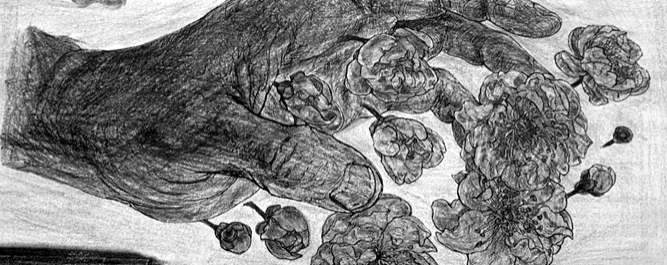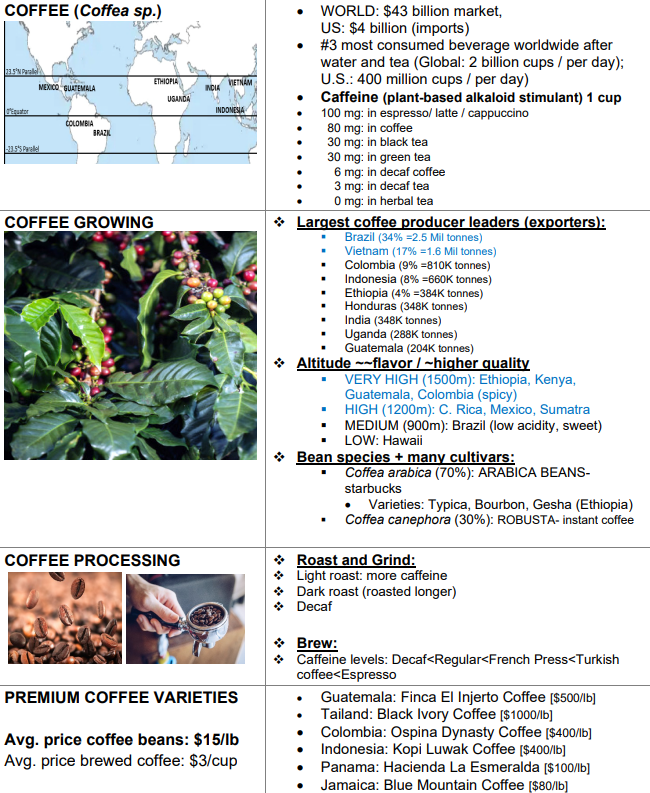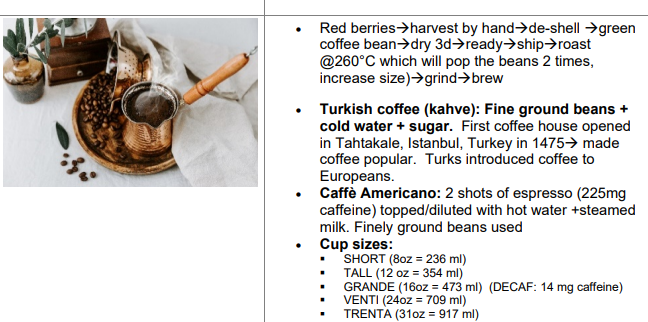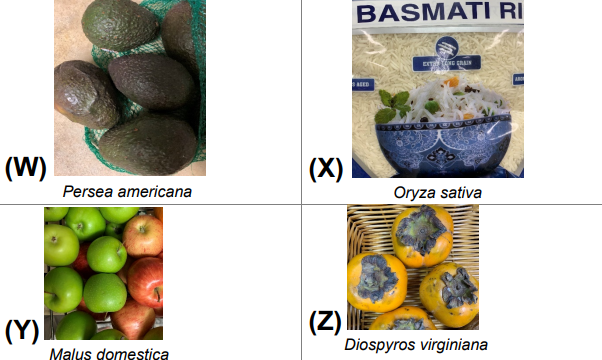1.22: Coffee Growing, Roast, Grind, and Beans
- Page ID
- 73653
\( \newcommand{\vecs}[1]{\overset { \scriptstyle \rightharpoonup} {\mathbf{#1}} } \) \( \newcommand{\vecd}[1]{\overset{-\!-\!\rightharpoonup}{\vphantom{a}\smash {#1}}} \)\(\newcommand{\id}{\mathrm{id}}\) \( \newcommand{\Span}{\mathrm{span}}\) \( \newcommand{\kernel}{\mathrm{null}\,}\) \( \newcommand{\range}{\mathrm{range}\,}\) \( \newcommand{\RealPart}{\mathrm{Re}}\) \( \newcommand{\ImaginaryPart}{\mathrm{Im}}\) \( \newcommand{\Argument}{\mathrm{Arg}}\) \( \newcommand{\norm}[1]{\| #1 \|}\) \( \newcommand{\inner}[2]{\langle #1, #2 \rangle}\) \( \newcommand{\Span}{\mathrm{span}}\) \(\newcommand{\id}{\mathrm{id}}\) \( \newcommand{\Span}{\mathrm{span}}\) \( \newcommand{\kernel}{\mathrm{null}\,}\) \( \newcommand{\range}{\mathrm{range}\,}\) \( \newcommand{\RealPart}{\mathrm{Re}}\) \( \newcommand{\ImaginaryPart}{\mathrm{Im}}\) \( \newcommand{\Argument}{\mathrm{Arg}}\) \( \newcommand{\norm}[1]{\| #1 \|}\) \( \newcommand{\inner}[2]{\langle #1, #2 \rangle}\) \( \newcommand{\Span}{\mathrm{span}}\)\(\newcommand{\AA}{\unicode[.8,0]{x212B}}\)

How do you take your coffee–regular or decaf? Coffee is the most popular drink in the U.S. However, coffee plant species growing is dominantly around the equator countries such as Brazil, Colombia, Ethiopia, and Indonesia.
Coffee plant (Coffea sp.), native to south west Ethiopia with very little genetic diversity, comes from beans of coffee fruit (a.k.a. berry or cherry). A combination of its susceptibility to extreme temperature changes and considering its low genetic diversity make breeders focus on developing more robust shade grown coffee cultivars worldwide.
- SLO 22.01: Apply the best practices for learning coffee cultivation
- SLO 22.02: Describe the characteristics of coffee plant (Coffea arabica)
- SLO 22.03: Describe the characteristics of coffee processing
- SLO 22.04: Describe the characteristics of coffee brewing
- SLO 22.05: Identify given plant species with their scientific names based on their key features
- SLO 22.06: Explain the differences between various tea coffees
- SLO 22.07: Explain the differences between decaf, and regular coffee


- Assessment 1: TRUE or FALSE: Coffee is native to tropical East Africa highlands (Ethiopia).
- Assessment 2: TRUE or FALSE: 40% of the world’s coffee is produced by Brazil.
- Assessment 3: TRUE or FALSE: Finland drinks the most coffee per person in the world.
- Assessment 4: TRUE or FALSE: U.S. is the world's largest coffee importer (2.5 Mil lb.).

- TRUE
- TRUE
- TRUE
- TRUE


